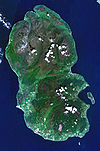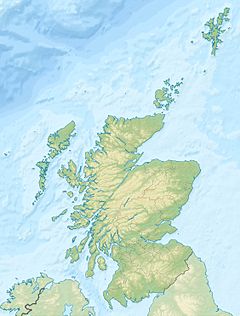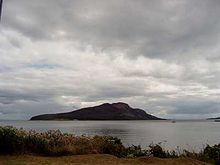- Holy Isle, Firth of Clyde
-
For other uses, see Holy Island (disambiguation).
Holy Isle Location Holy Isle shown within Scotland OS grid reference NS063297 Names Gaelic name An t-Eilean Àrd or Eilean MoLaise Meaning of name "the high island" or "Laisren's island" in Gaelic. Area and summit Area 253 ha (0.98 sq mi) Area rank 97 Highest elevation Mullach Mòr 314 m (1,030 ft) (a Marilyn) Population Population 13 Population rank 68= out of 97 Groupings Island group Firth of Clyde Local Authority North Ayrshire 

References [1][2][3][4] If shown, area and population ranks are for all Scottish islands and all inhabited Scottish islands respectively. Population data is from 2001 census. The Holy Isle, Firth of Clyde (Scottish Gaelic: Eilean MoLaise) is one of a number of islands in the United Kingdom which go under the name "Holy Island". It is located in the Firth of Clyde off the west coast of central Scotland, inside Lamlash Bay on the larger island of Arran.
Contents
Details
Mullach Mòr Elevation 314 m (1,030 ft) Prominence 314 m (1,030 ft) Listing Marilyn Translation Big hill (Gaelic) Pronunciation Scottish Gaelic: [ˈmul̪ˠəx ˈmoːɾ] Location Location Firth of Clyde, Scotland Coordinates 55°31′30″N 5°04′20″W / 55.525°N 5.07222°WCoordinates: 55°31′30″N 5°04′20″W / 55.525°N 5.07222°W Topo map OS Landranger 69 OS grid NS063297 The island is around 3 kilometres (1.9 mi) long and around 1 kilometre (0.6 mi) wide. Its highest point is the hill Mullach Mòr.
The island has a long history as a sacred site, with a spring or Holy well held to have healing properties, the hermit cave of 6th Century monk Saint Molaise, and evidence of a 13th Century monastery. An old Gaelic name for the island was Eilean MoLaise, Molaise's Island; this is the origin (via Elmolaise and Limolas) of "Lamlash", the name of the village on Arran that faces Holy Island.
Some runic writing is to be found on the roof of St. Molaise's cave.
The Viking fleet sheltered between Arran and Holy Isle before the Battle of Largs.
The rare Rock Whitebeam tree is found on the island, an essential link in the evolution of the Arran Whitebeam species, Sorbus arranensis, Sorbus pseudofennica and Sorbus pseudomeinichii. These are indigenous and unique to Arran.
The island is now owned by the Samyé Ling Buddhist Community, who belong to the Kagyu school of Tibetan Buddhism. The settlements on the island include the Centre for World Peace and Health, founded by Lama Yeshe Losal, on the north of the island. This is an environmentally designed residential centre for courses and retreats which extends the former farm house. It has solar water heating and a reed-bed sewage treatment system. The approach from the ferry jetty is decorated with Tibetan flags and stupas.
On the southern end of the island lives a community of nuns who are undertaking three year retreats. The remainder of the island is treated as a nature reserve with wild Eriskay ponies, Saanen goat, Soay sheep and the replanting of native trees.
There is a regular ferry service from Lamlash, and the island is popular with holiday makers staying on Arran.
Gallery
-
The Centre for World Peace and Health, with Tibetan flags and stupas
Footnotes
- ^ 2001 UK Census per List of islands of Scotland
- ^ Haswell-Smith, Hamish (2004). The Scottish Islands. Edinburgh: Canongate. ISBN 1841954543.
- ^ Ordnance Survey
- ^ Iain Mac an Tailleir. "Placenames". Pàrlamaid na h-Alba. http://www.scottish.parliament.uk/vli/language/gaelic/pdfs/placenamesF-J.pdf. Retrieved 2007-07-23.
External links
Arran Main villages 
Smaller villages and settlements Mountains and hills Goat Fell · Beinn Tarsuinn · Caisteal Abhail · Cìr Mhòr · Creag Ghlas Laggan · Tighvein · Sleeping WarriorHistory Environment Arran Whitebeams · Glenashdale FallsEconomy The Arran Banner · Arran Single MaltSurrounding islands Islands of Scotland Northern Isles 
Hebrides Other Categories:- Islands of the Clyde
- Marilyns of Scotland
- Mountains and hills of the Scottish islands
- North Ayrshire
-
Wikimedia Foundation. 2010.





